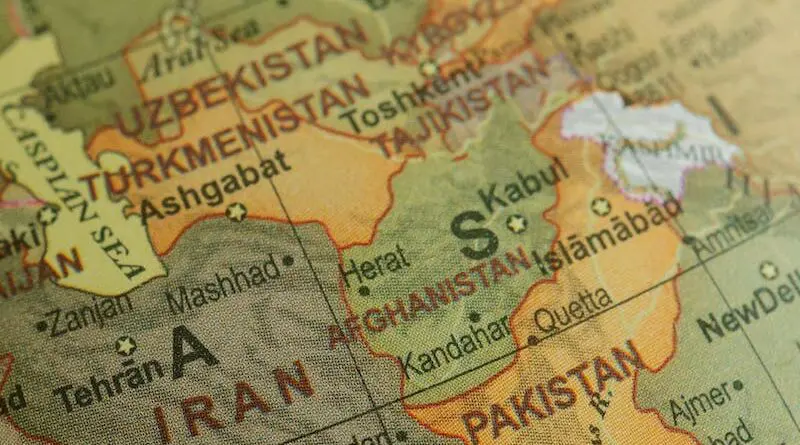Tajikistan’s policies toward neighboring Taliban-ruled Afghanistan are reaching a pivotal moment. Tajik President Emomali Rahmon and his government have always viewed the Taliban as a threat, and that position has not changed since the Taliban returned to power in August 2021. However, there is a bigger threat to Tajikistan growing in Afghanistan, and it might take cooperation with the Taliban to neutralize it.
Additionally, the other Central Asian countries and China, Iran, and Russia are engaging with the Taliban government. Tajikistan risks missing out on opportunities that these countries are opening in Afghanistan. Following the lead of these countries presents Tajikistan with a different set of problems. Tajik authorities have been warning the country’s people and the international community about the Taliban threat for nearly 30 years. Tajikistan’s rigid stance against the Taliban government has brought Rahmon’s government support from Tajikistan’s people and other countries. Making peace with the Taliban will be difficult to explain to Tajik citizens. It will also remove one of the greatest incentives for foreign governments to continue decades of generous financial and security support for Rahmon’s government.
Enemies from the Start
President Rahmon is unique among the current leaders of countries bordering Afghanistan. He is the only leader who was in power when the Taliban ruled Afghanistan in the late 1990s.
In the late 1990s, all the Central Asian presidents, except the Turkmen president, viewed the Taliban as a threat and shunned any contact with them. Rahmon’s government and the government of Uzbekistan’s then-President Islam Karimov aided ethnic Tajik and Uzbek groups fighting the Taliban in northern Afghanistan. The potential danger from the Taliban was acutely felt in Tajikistan where there was civil war from 1992 to 1997. The Rahmon government’s battlefield opponent was the United Tajik Opposition, a coalition of groups in which the Islamic Renaissance Party of Tajikistan (IRPT) was the backbone. In the early years after the Taliban appeared, most people knew little about the group except that they were Islamic extremists.
Rahmon had reason to be one of the strongest critics of the Taliban. Other governments alarmed at the Taliban’s advance through Afghanistan also saw that Tajikistan, the poorest Central Asian country emerging from a five-year civil war, needed assistance to ensure the Taliban could not find a foothold or sympathizers inside Tajikistan. The Taliban and other militant groups continued operating in northern Afghanistan after foreign forces entered the country. Tajikistan became a frontline in the war on terror, and Rahmon realized that warning about threats from Afghanistan prompted countries and organizations to send additional finances and security assistance.
His continued opposition to the Taliban after August 2021 earned Rahmon invitations to visit the European Parliament and France in October 2021.
A Safer Border
Tajikistan’s government is slowly opening ties with the Taliban. The first reported contact occurred after militants from the Islamic State of Khorasan (ISK) launched several rockets from northern Afghanistan into Tajikistan on May 7, 2022. Former Tajik security officer Samariddin Chuyanzoda traveled to Kabul on May 14 to meet with Taliban representatives. The Taliban were facing sporadic attacks from ISK before foreign troops departed Afghanistan, and those attacks continue to this day. The Taliban claim that, among the ISK militants they have killed or captured in the last three years, some are citizens of Tajikistan.
Just weeks before Chuyanzoda made his trip to Kabul, ISK increased its recruiting propaganda in the Tajik language, targeting Tajiks in Afghanistan and Tajikistan.
There are also the militants of Jamaat Ansarullah, a terrorist group originating in Tajikistan that allied themselves with the Taliban during the final years foreign forces were in Afghanistan. During the first months after the Taliban’s recapture of Afghanistan when the Tajik government and Taliban were exchanging threats, the Taliban stationed Jamaat Ansarullah militants, freshly armed with US weapons seized by the Taliban when they took control of Afghanistan.
According to reports in February 2024, Tajik and Taliban officials met at the request of Tajikistan toward the end of 2023 to discuss what to do with the Jamaat Ansarullah fighters. Tajik authorities reportedly wanted the Jamaat Ansarullah militants extradited to Tajikistan. The Taliban instead offered to act as a mediator in negotiations between the two groups.
Jamaat Ansarullah’s leadership said they would only talk if the Tajik government met several unreasonable—for Tajik authorities—conditions including declaring Tajikistan an Islamic state and removing Russian troops stationed in Tajikistan.
However, contact between Tajik and the Taliban had been established. As recently as August 2024, Saimumin Yatimov, the leader of Tajikistan’s security service, visited Kabul to reportedly discuss strengthening ties between Tajikistan and the Taliban.
Aside from militants, Tajikistan risks being left out of trade routes through Afghanistan that are being planned or already slowly opening.
Kazakhstan, Turkmenistan, and Uzbekistan have all been working with Taliban officials to improve connectivity between Central Asia and Afghanistan and hopefully extend proposed trade routes to Iran and the Arabian Sea. Among these projects are the Trans-Afghan railway connecting Uzbekistan (and through Uzbekistan, other Central Asian countries) to Pakistan, a railway from Kazakhstan through Turkmenistan and on to Herat, Afghanistan with spurs to Iran or continuing through Afghanistan to Kandahar and Spin Boldak on the Pakistani border.
Another proposed railway is the 250-mile Tajikistan–Afghanistan–Turkmenistan (TAT) line. That project dates back more than a decade. However, in August 2024, Tajikistan’s Transport Ministry signed a protocol with the Korea International Cooperation Agency for a feasibility study for the 30-mile Tajik section of the railway. Tajik Transport Minister Azim Ibrohim said the line would connect Tajikistan to markets in South Asia, and acting South Korean Ambassador to Tajikistan Jeon Sung-sik said the railway would “enable Tajikistan to access maritime routes and become a crucial link in international transportation.” China has shown interest in this route also as part of a multimodal trade route that passes through eastern Tajikistan to the Chinese border by road.
Tajikistan has continued to export electricity to Afghanistan since the Taliban returned to power. The power transmission lines were built during the years foreign troops were in Afghanistan and in the months after the Taliban seized control, Tajikistan’s electricity shipments to Afghanistan were one of the only links preserved with Tajikistan’s southern neighbor. The Taliban said early on that they would pay for the electricity, and they have kept their word.
In February 2024, the World Bank announced construction of the Central Asia–South Asia (CASA-1000) power line had resumed. CASA-1000 aims to use hydropower plants in Kyrgyzstan and Tajikistan to bring one thousand megawatts (MW) of electricity to Pakistan and 300 MW to Afghanistan.
The Trade-Off
Afghanistan has been a constant source of concern since Tajikistan became independent in 1991. For Tajikistan, an amicable understanding with the Taliban represents an unprecedented sense of security plus economic and trade opportunities.
There are complications, however.
Rahmon has repeatedly called the Taliban a threat to the security of Tajikistan and Central Asia more broadly for 30 years.
Rahmon has mentioned the plight of ethnic Tajiks in Afghanistan since the Taliban returned to power and called for an inclusive government. Those remarks have earned Rahmon some rare widespread public support in Tajikistan.
How would Rahmon explain to his people that the Taliban can be a partner to Tajikistan?
Underscoring the sensitivity of this problem, Rahmon banned the IRPT saying they were a terrorist group. Before being banned, the IRPT was the second largest political party in Tajikistan, behind Rahmon’s People’s Democratic Party of Tajikistan. The 1997 Tajik Peace Accord appointed IRPT representatives to government positions. Until 2015, the IRPT had deputies in the lower house of the Tajik parliament.
The IRPT is far more moderate than the ultra-Orthodox Taliban whose brutal rule of the late 1990s has carried over into the current regime. So how can the IRPT be such a threat? And how can the Taliban be a party with which Tajik authorities can associate?
More importantly, the Tajik government has profited greatly from being a neighbor to unstable and menacing Afghanistan. Tajikistan has always been donor dependent and has received generous help largely because it has been a frontline against Islamic radicalism coming out of Afghanistan.
Social programs, education, water purification, energy projects, and more have been funded by international organizations and individual countries. Part of the reason for this aid was to improve the socioeconomic situation in Tajikistan and strengthen the resolve of the country’s people against the lure of groups such as the Taliban or ISK.
Security cooperation is probably the key benefit Tajikistan has received.
On September 1, 2021, the US Embassy in Tajikistan posted on its website that a US-funded project had just launched to build new facilities for a Tajik border guard unit stationed along the Afghan frontier. The statement said some of the new additions “will allow the Border Patrol to quickly deploy forces to border areas in response to threats.” The statement noted that, since 2002, the US government spent more than $300 million to repair or reconstruct 12 border posts, nine border crossings, and three training centers for border guards. The US has also provided nonlethal aid to Tajikistan’s border guards including border surveillance, night-vision equipment, jeeps, quadbikes, and sniffer dogs.
The European Union as a body and individual countries within the EU, NATO, Russia, China, and other parties have also provided military equipment and uniforms and built facilities for border forces.
Conclusion
If the Tajik government and Taliban can reach a durable truce and establish some form of cooperation, the threat level for Tajikistan diminishes. The concerns of foreign governments and organizations for Tajikistan’s security also subside. Peace with the Taliban could significantly reduce the amount of foreign financial and security assistance Tajikistan has become accustomed to seeing.
In an odd contradiction, instability in Afghanistan has been good for Rahmon’s government. However, harsh stability in Afghanistan imposed by the Taliban could halt hundreds of millions of dollars in aid that has been propping up the Tajik government for three decades.









